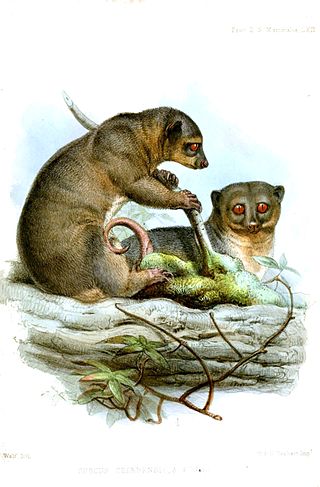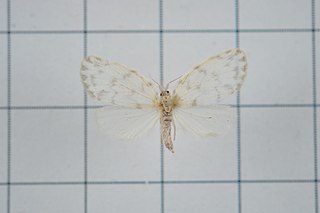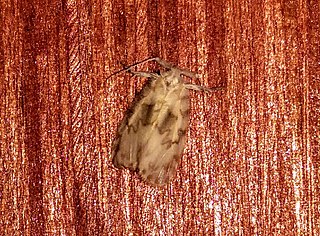
The North Sulawesi babirusa is a pig-like animal native to Sulawesi and some nearby islands in Indonesia. It has two pairs of large tusks composed of enlarged canine teeth. The upper canines penetrate the top of the snout, curving back toward the forehead. The North Sulawesi babirusa is threatened from hunting and deforestation.

The Celebes warty pig, also called Sulawesi warty pig or Sulawesi pig, is a species in the pig genus (Sus) that lives on Sulawesi in Indonesia. It survives in most habitats and can live in altitudes of up to 2,500 m (8,000 ft). It has been domesticated and introduced to a number of other islands in Indonesia.
The Sulawesi yellow bat is a species of vesper bat. It is found only in Indonesia.

The Celebes rat is a species of rodent in the family Muridae. It is found only in Sulawesi, Indonesia.

The dark-eared myza, also known as the lesser streaked honeyeater, is a species of bird in the family Meliphagidae. It is endemic to the island of Sulawesi in Indonesia. There are two subspecies, Myza celebensis celebensis which is found in mountainous parts of northern, central and southeastern Sulawesi, and Myza celebensis meridionalis from mountains in southern Sulawesi.

The Sulawesi dwarf cuscus is a species of arboreal marsupial in the family Phalangeridae that is endemic to Sulawesi and nearby islands in Indonesia. It inhabits tropical moist lowland forest and is nocturnal, folivorous and usually found in pairs. S. celebensis is threatened by hunting and deforestation.

Harpyionycteris is a genus of megabat in the family Pteropodidae. It contains the following species:

The Sulawesi horseshoe bat is a species of bat in the family Rhinolophidae. It is endemic to Indonesia.

The Sulawesi rousette or Sulawesi fruit bat is a species of megabat in the family Pteropodidae endemic to Sulawesi, an island in Indonesia. It is presently the only member of the genus Pilonycteris.

Chamaita is a genus of moths in the subfamily Arctiinae. The genus was erected by Francis Walker in 1862. Species are distributed throughout India, Sri Lanka, and Borneo.
The Timor warty pig is a subspecies of Sus celebensis, or Celebes warty pig. Though described as a separate species, it is a feral form of the Celebes warty pig found in the Lesser Sunda Islands.

The Sulawesi harpy fruit bat is a species of megabat in the family Pteropodidae. It is endemic to Indonesia where it is found in Sulawesi and in Soloi on Buton island.

Chamaita hirta is a moth of the family Erebidae first described by Alfred Ernest Wileman in 1911. It is found in Taiwan.
Chamaita barnardi is a moth of the family Erebidae first described by Thomas Pennington Lucas in 1894. It is found in Australia.
Chamaita metamelaena is a moth of the family Erebidae first described by George Hampson in 1900. It is found in New Guinea.
Chamaita neuropteroides is a moth of the family Erebidae first described by George Hampson in 1894. It is found in Assam, India.
Chamaita nubifera is a moth of the family Erebidae first described by George Hampson in 1918. It is found in the Philippines.

Chamaita nympha is a moth of the family Erebidae. It is found in Sri Lanka.
Roepkiella celebensis is a moth in the family Cossidae. It is found on Sulawesi.

The Nudariina are a subtribe of lichen moths in the family Erebidae. The taxon was described by Carl Julius Bernhard Börner in 1920.












